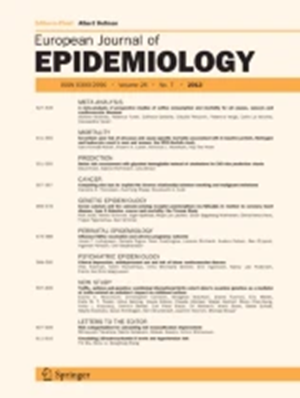Maternal cannabis use in pregnancy, perinatal outcomes, and cognitive development in offspring: a longitudinal analysis of the ALSPAC cohort using paternal cannabis use as a negative control exposure.
IF 5.9
1区 医学
Q1 PUBLIC, ENVIRONMENTAL & OCCUPATIONAL HEALTH
引用次数: 0
Abstract
Maternal cannabis use in pregnancy is reported to be associated with perinatal and neurodevelopmental outcomes in offspring. Such associations, however, may be biased by residual confounding by socioeconomic position (SEP). To assess confounding, we use paternal cannabis use in pregnancy as a negative control exposure. We use data from 15,013 mother-father-child trios from the ALSPAC birth cohort, with participants initially recruited between 1990 and 1992. Exposures were maternal and paternal cannabis use during pregnancy. Neonatal anthropometry, perinatal, cognitive, and neurodevelopmental outcomes were modelled as a function of maternal and paternal cannabis use in pregnancy, adjusting for household-level SEP markers and maternal and paternal tobacco, alcohol, and drug use in pregnancy. We compared the strength of the association between maternal and paternal cannabis on outcomes using Wald tests. 5 and 13% of mothers and fathers reported cannabis use, which was inversely related to measures of SEP. Maternal cannabis use during pregnancy was associated with decreased infant birth weight (b = - 110.2 g, 95% CI - 185.1 to - 35.3 for any cannabis use) and length (b = - 0.45 cm, 95% CI - 0.84 to - 0.07). Maternal cannabis during pregnancy was also associated with neonatal special care admission (odds ratio 1.64, 95% CI 1.05 to 2.56) and lower education achievement scores at age 16 (b = - 19.2, 95% CI - 32.0 to - 6.3). Maternal cannabis use in pregnancy was modestly associated with perinatal outcomes and markers of cognitive development. However, most associations were attenuated after controlling for potential confounders, including SEP, and associations were not quantitatively different from paternal cannabis use. The association of maternal cannabis use in pregnancy with perinatal or cognitive outcomes in offspring may be driven by residual confounding, including SEP, rather than causal biological effects.母亲在怀孕期间使用大麻,围产期结局和后代的认知发育:使用父亲使用大麻作为阴性对照暴露的ALSPAC队列的纵向分析。
据报道,孕妇在怀孕期间使用大麻与后代的围产期和神经发育结果有关。然而,这种关联可能会因社会经济地位(SEP)的残留混淆而产生偏差。为了评估混淆,我们使用父亲在怀孕期间使用大麻作为阴性对照暴露。我们使用了来自ALSPAC出生队列的15,013个母亲-父亲-孩子三人组的数据,参与者最初是在1990年至1992年期间招募的。暴露是母亲和父亲在怀孕期间使用大麻。新生儿人体测量、围产期、认知和神经发育结果作为母亲和父亲在怀孕期间使用大麻的功能建模,调整家庭水平SEP标记和母亲和父亲在怀孕期间使用烟草、酒精和药物。我们使用沃尔德检验比较了母亲和父亲大麻对结果的关联强度。5%和13%的母亲和父亲报告使用大麻,这与SEP测量呈负相关。怀孕期间母亲使用大麻与婴儿出生体重(b = - 110.2 g,任何大麻使用95% CI - 185.1至- 35.3)和长度(b = - 0.45 cm, 95% CI - 0.84至- 0.07)减少有关。孕妇在怀孕期间吸食大麻也与新生儿特殊护理住院(优势比1.64,95% CI 1.05至2.56)和16岁时较低的教育成就分数相关(b = - 19.2, 95% CI - 32.0至- 6.3)。孕妇在怀孕期间使用大麻与围产期结局和认知发展标志物有适度关联。然而,在控制了包括SEP在内的潜在混杂因素后,大多数关联减弱,并且与父亲使用大麻的关联在数量上没有差异。怀孕期间母亲使用大麻与后代围产期或认知结局的关联可能是由残留混杂因素(包括SEP)驱动的,而不是因果生物学效应。
本文章由计算机程序翻译,如有差异,请以英文原文为准。
求助全文
约1分钟内获得全文
求助全文
来源期刊

European Journal of Epidemiology
医学-公共卫生、环境卫生与职业卫生
CiteScore
21.40
自引率
1.50%
发文量
109
审稿时长
6-12 weeks
期刊介绍:
The European Journal of Epidemiology, established in 1985, is a peer-reviewed publication that provides a platform for discussions on epidemiology in its broadest sense. It covers various aspects of epidemiologic research and statistical methods. The journal facilitates communication between researchers, educators, and practitioners in epidemiology, including those in clinical and community medicine. Contributions from diverse fields such as public health, preventive medicine, clinical medicine, health economics, and computational biology and data science, in relation to health and disease, are encouraged. While accepting submissions from all over the world, the journal particularly emphasizes European topics relevant to epidemiology. The published articles consist of empirical research findings, developments in methodology, and opinion pieces.
 求助内容:
求助内容: 应助结果提醒方式:
应助结果提醒方式:


